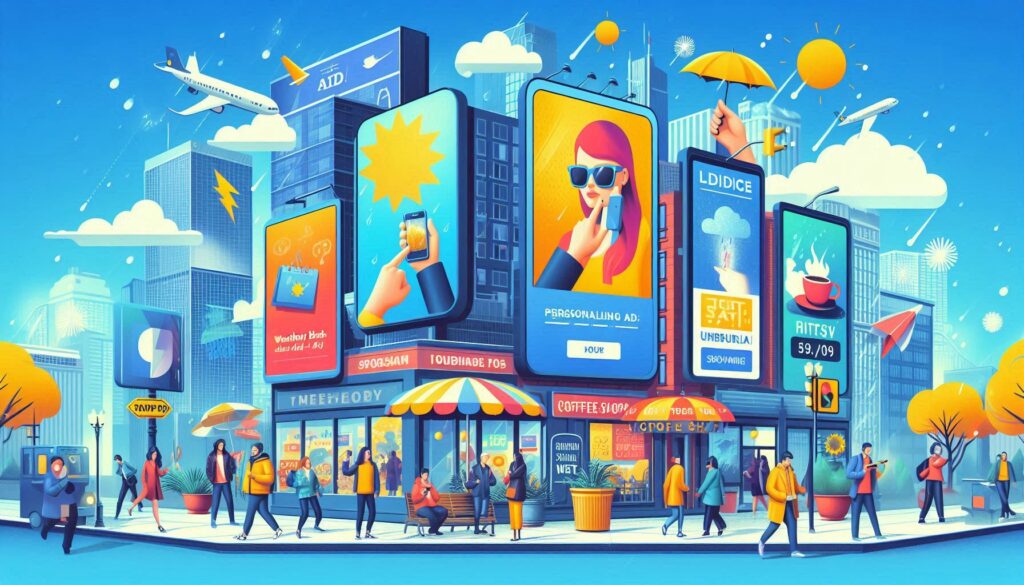If you’ve been in digital marketing long enough, you’d know when a strategy has legs. Weather-based advertising is one such strategy, that’s quietly picking up speed in 2025. This is not about showing an ad for umbrellas when it rains. It is about connecting with people in a way that feels natural and timely, using the weather they’re experiencing right now. This approach is powerful and practical, yet underused. Now that weather-based advertising is catching on, it’s important to know how to make it work for your campaigns.
What Is Weather-Based Advertising?
Weather-based advertising uses real-time or forecasted weather data to deliver ads that match what’s happening outside someone’s window. If it’s a chilly morning, a coffee shop might push ads for hot cocoa. If it’s a sunny afternoon, a retailer could highlight sunglasses or flip-flops. The idea is to align your message with the exact moment when weather shapes what people want to buy or do.
Here’s how it comes together:
- Weather Data Feeds: Platforms tap into sources like The Weather Company, which tracks conditions across millions of locations globally every 15 minutes, or WeatherAds, which uses over 70 signals like temperature, rainfall, humidity, or even pollen levels.
- Automated Triggers: These systems plug into ad platforms like Google Ads, Meta, or The Trade Desk. Marketers set rules such as, “show ice cream ads when it’s above 27°C” or “pause winter coat ads if it’s sunny”. The platform takes care of the rest, tweaking bids or swapping visuals automatically.
- Customized Ads: Dynamic Creative Optimization (DCO) tailors ad content on the fly. For instance, a clothing brand might display a raincoat during a drizzle or a swimsuit in heat, all based on local conditions.
Michaels, a crafts retailer, ran weather-triggered ads through WeatherAds to promote indoor projects three days before rainy forecasts, driving a significant sales lift by aligning with when consumers plan craft activities. This clearly demonstrates how weather can be a direct line to what customers need at the moment.
Why Weather Drives Results
Weather isn’t just background noise—it shapes how people shop, eat, and feel. A 2025 WeatherAds report found that a 1°F temperature increase can lift cold drink sales by 2%. Rainy days boost online shopping by 10–15%. Cloudy skies nudge people toward comfort foods, while sunny days spark outdoor purchases. As marketers, we’re always looking for ways to be relevant, and weather data lets us tap into those real-time needs.
This approach also fits the shift toward privacy-focused marketing. With third-party cookies disappearing in 2025, weather data offers a way to personalize ads without tracking individuals. Platforms like WeatherAds use anonymized, aggregated signals such as precipitation or UV index to target audiences while staying compliant with GDPR and CCPA. It’s a clean, effective way to reach people without crossing privacy lines.
Although only a small percentage of brands use weather-based ads, adopters see strong returns. According to the 2025 WeatherAds Report, La Redoute’s weather-triggered out-of-home ads for seasonal clothing drove 34% more website traffic and 17% higher sales. Bravissimo’s PPC swimwear ads during sunny forecasts boosted revenue by 600%. These results stem from meeting customers when they’re ready to act.
Who’s Making It Work?
Retail and CPG brands lead the way, as their products tie directly to weather-driven needs:
Retail: Local Relevance, Big Impact
Burton Menswear used weather-responsive website promotions to boost conversions by 11.6% by tailoring product recommendations to local weather.
Walmart promoted cooling products during warm weather via Google Ads, achieving a 27% in-store sales increase.
Goodyear used WeatherAds to advertise tires during adverse weather, enhancing campaign performance.
CPG: Everyday Products, Everyday Weather
Cornetto used weather data to promote ice cream on warm, sunny days, achieving significant sales and market share uplift.
Stella Cidre reported a 65.6% year-on-year sales increase during a weather-responsive DOOH campaign.
Neutrogena’s weather-triggered sunscreen ads increased purchase intent by 43%, showing how weather aligns with consumer emotions.
The Tools Behind the Weather-Based Advertising Strategy
Two platforms are built to support weather-based advertising. They are WeatherAds and The Weather Company.
WeatherAds: Easy and Affordable
WeatherAds integrates with Google Ads, Meta, TikTok, YouTube, and DV360, with setup in 15 minutes using 70+ weather signals. Its visual dashboard simplifies campaign creation. It offers budget-friendly options for small-to-medium businesses, with pricing from $25/month.
The Weather Company: Built for Scale
The Weather Company uses AI to analyze weather, sales, and anonymized third-party data across 44,000 U.S. ZIP codes, triggering hyper-local ads. It is ideal for large brands needing precise campaigns. However, its higher costs and complexity may challenge smaller brands.
What to Watch Out For in Weather-Based Advertising
Privacy Questions
Weather data is anonymized, but pairing with location signals requires GDPR/CCPA compliance. WeatherAds and The Weather Company use cookieless data to address this. Brands should disclose data practices in privacy policies.
Weather’s Unpredictability
DCO adjusts creatives in real time, and The Weather Company’s AI-driven forecasts help mitigate variability.
Cost and Setup
Only 10% of brands use weather-based ads due to costs, but WeatherAds’ free trials and tiered pricing is helpful.
Attribution
Isolating the weather’s impact is tricky because consumer behavior is influenced by multiple factors, making it hard to attribute sales or engagement solely to weather conditions. For example, a spike in umbrella sales during rain could also reflect seasonal trends or promotions.
How to Start Your Weather-Based Advertising Strategy
- Pick a Tool: Try WeatherAds for its simplicity or The Weather Company if you’re scaling big. Both offer demos or trials.
- Start Small: Test one campaign with a clear trigger—like promoting ice cream when it’s above 75°F. Measure results with A/B testing.
- Use DCO: Invest in dynamic creatives to adapt ads to local conditions. Even small tweaks, like changing a model’s outfit, boost engagement.
- Track ROI: Use analytics to compare weather-triggered ads to your baseline. Look for lifts in conversions, traffic, or sales.
- Stay Transparent: Be upfront about data use to ease privacy concerns. A simple note in your ads or privacy policy goes a long way.
Weather-based advertising connects with customers when they need you most, from snowy days to sunny afternoons. From Decathlon’s 103% conversion boost to Bravissimo’s 600% revenue spike, the data shows it works. In a crowded market, weather-based ads feel personal, not pushy. So, as you plan your next campaign, look outside and turn data into demand—it might just hold the key to your biggest win yet.


